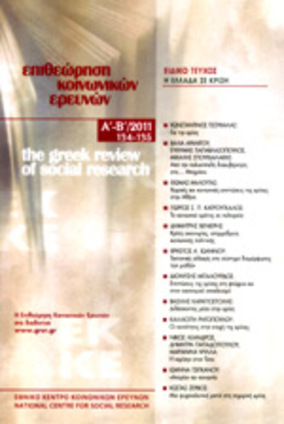An essay on comparison as a method in social sciences
Part of : Επιθεώρηση κοινωνικών ερευνών ; Vol.29, 1977, pages 44-54
Issue:
Pages:
44-54
Section Title:
Articles
Abstract:
I would summarize the argument of this paperin the following points:a) Every scientific research is of political relevancein the Aristotelian as well as in a politoeconomiesense, or it is useless.b) Time and space as the two definitional elementsof comparison give the historical dimensionof the phenomena. Difference or similarity ofphenomena is thus reduced to difference of similarityof conditions at two or more points in timeand in space, which is a question of the reproducibilityof historical conditions.c) Comparison as a method implies the comparabilityof two things and aims at showing equalitybetween them or proving their inequality.d) Comparability is a function of the concept usedto define a phenomenon and in this sense relativeby definition.e) There are two distinct aspects in the process ofcomparison: the one referring to the identificationof a phenomenon—which means defining itsproperties—the other to the degree of similarity(or equality) of two or more phenomena at two ormore different points in time and/or in space.f) Comparison in a narrow sense as a method insocial sciences aims at measuring the degree ofsimilarity between two or more objects in timeand/or in space. The comparative method in anarrow sense is thus the techniques and proceduresof research in the service of the above aim.g) Every technique of measuring phenomena inthe process of comparing needs to be justified inits scope, in its implications, finally in relation tothe object of measurement.h) The operation of identification of phenomenain the comparative method is common to all socialsciences. Comparison as an operation ofmeasuring the degree of similarity between two ormore phenomena is not identical in all social sciences.The techniques of measurement for eachdiscipline differ according to the phenomena to beobserved and compared as well as according tothe general scope of comparing.i) The comparative method in a narrow sense hasbeen proposed and developed in the postwarperiod primarily as a method of comparingphenomena across cultures and nations.j) The main three plausible reasons for crossculturalcomparative research are: 1) the concernwith the economic development of developingcountries in the postwar period (historicalreason); 2) the testing of hypotheses and theoriesbeyond national boundaries aiming at revealing«laws» (comparison as a substitute for experiment)(methodological reason); 3) practical policyaims (political reason).k) The concept of «nation» is to be preferredto the concept of «culture» in discussing comparisonas a method of social research; crosscultur-al is taken, therefore, to mean crossnational.l) Diffusion leads to a homogenisation of phenomenaacross cultures and nations which has been increasingin the postwar period although this hasnot yet led to an elimination of national differences.m) It is possible to observe tendencies across culturesand nations, furthermore to detect developments,but it is questionable whether it is possibleto compare them in a strict sense for three mainreasons referring to the problem of identification,the reliability of data and measurement itself.n) Crosscultural comparison aiming at testingtheories or general hypotheses must find in atleast two systems the causes leading to the sameeffect in both of them (explanation part of atheory), furthermore to fix the conditions that aresufficient and necessary for a reproduction of thesame phenomenon at a later point in time or at adifferent point in space (prediction part of atheory). Such a task has been so far unsuccessful.o) Policy implications arising out of a study inother nations are only of conditional relevance forsome other. Even assuming the similarity of conditionsit is uncertain if the development of aphenomenon will follow the same track in a newcountry that it had followed in one or more othercountries previously.p) Also the comparative method is either uselessor is of political relevance (point a). On thegrounds of conclusion under o, the comparativemethod must be declared either as «useless» orpolitical in terms of politics, and not in terms ofpolicy implementation.
Subject:
Subject (LC):




